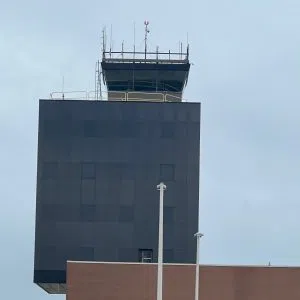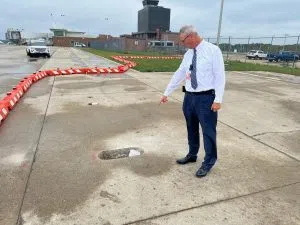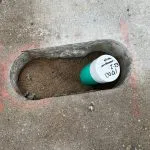By: Phil Luciano
As the director of the Peoria airport, Gene Olson spends a lot of time gazing skyward.
Lately, though, he has been peering down – way down.

Built in 1959, this is the current air traffic control tower at Gen. Wayne A. Downing Peoria International Airport. (Photo by Phil Luciano.)
At Gen. Wayne A. Downing Peoria International Airport, preliminary work is underway for the construction of a new air traffic control tower. The project, including a base building below the tower, will cost $60 million, or triple the original estimate in 2016, Olson says. Part of the extra cost – more than $3 million – involves probing the tower site to find and fill underground air pockets remaining from dormant coal mines, some abandoned more than a century ago.
Moreover, the airport isn’t the only place that sits above such underground pockets, Olson says. Many dwellings in and around Peoria likely sit atop former coal mines.
“It’s not a commonly known thing,” Olson says.
When Peoria residents voted to build an airport in 1932, coal mining was past its heyday locally. Though Peoria County had hosted 650 mines of various sizes, most had shuttered by the time the airport underwent construction in Limestone Township.
Original architects had access to maps of coal mines, But many records were inexact, incomplete or incorrect.
“It wasn’t done with today’s technology,” Olson says. “So, there was some guesswork.”
There has been just one mine-related mishap at the airport. In 1949, a runway apron – essentially, a paved parking space for planes – sunk slightly over “several hundred square yards” above an old mine. Olson says. Aside from the apron, there was no damage, nor was anyone hurt. The spot was filled and repaved, and today is part of the grounds of the Illinois Army National Guard property at the airport.
Olson knows of no further mine troubles at the airport. However, mines have been on his mind as plans loom for a new air traffic control tower.
The current tower dates back to 1959 and looks every bit its age. The roof leaks, and asbestos lurks in many places. Heating and cooling is capricious: if the temperature is 25 degrees, the furnace sometimes blows too hot, to the point staffers open windows. There is no women’s bathroom, as there were no female controllers in 1959. And the technology is wanting.
“It has ancient systems,” Olson says.
A 2016 project estimate of $20 million has zoomed to thrice that, mostly because of inflation, Olson says. The delay largely can be blamed on the search for funding, all of which will come from federal sources.

Gene Olson, director of Gen. Wayne A. Downing Peoria International Airport, points to one of multiple mine-mitigation holes at the site of a pending new air traffic control tower. (Photo by Phil Luciano.)
He expects work to begin in coming months on the base building. Next summer, construction should begin on the tower, with the entire project to be done in 2027.
First, though, the project is not going up, but down.
Olson and others have pored over old mining maps – some 100 or more years old, some torn and missing chunks. In the end, the maps aren’t completely trustworthy as to what lies below.

This is one of many multiple mine-mitigation holes at the site of a pending new air traffic control tower. When open pockets are found below, grout is pumped down to fill the open spaces. (Photo by Phil Luciano.)
“It’s like a honeycomb under there,” Olson says.
The shafts were 5 feet tall and 15 feet wide, with one 2.5 miles long. So, in and around the tower work site, mine-mitigation specialists from St. Louis have been probing the earth. Holes – 8 inches wide and sometimes almost 200 feet deep – have been dug downward.
Often, the probes have located pockets remaining from old shafts. In those cases, a special grout – “It’s like lower-strength cement,” Olson says – is being pumped down to fill the holes.
Mine-mitigation work could be finished within a few weeks. The cost will be about $3.5 million, which Olson calls a wise investment to ensure a solid foundation for the new tower.
“We’ve been ultra-conservative and probably grouting out farther than we probably need to,” Olson says. “ … We want to be extra careful.”
Listen to the interview with Peoria International Airport Director Gene Olson from The Phil Luciano Show here.







Comments